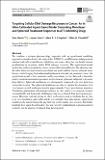Files in this item
Targeting cellular DNA damage responses in cancer : an in vitro-calibrated agent-based model simulating monolayer and spheroid treatment responses to ATR-inhibiting drugs
Item metadata
| dc.contributor.author | Hamis, Sara | |
| dc.contributor.author | Yates, James | |
| dc.contributor.author | Chaplain, Mark A. J. | |
| dc.contributor.author | Powathil, Gibin G. | |
| dc.date.accessioned | 2021-08-31T09:30:02Z | |
| dc.date.available | 2021-08-31T09:30:02Z | |
| dc.date.issued | 2021-10 | |
| dc.identifier | 275515925 | |
| dc.identifier | c1704657-424a-4321-b841-aa4431a07cb5 | |
| dc.identifier | 85113726386 | |
| dc.identifier | 000692473500001 | |
| dc.identifier.citation | Hamis , S , Yates , J , Chaplain , M A J & Powathil , G G 2021 , ' Targeting cellular DNA damage responses in cancer : an in vitro -calibrated agent-based model simulating monolayer and spheroid treatment responses to ATR-inhibiting drugs ' , Bulletin of Mathematical Biology , vol. 83 , no. 10 , 103 . https://doi.org/10.1007/s11538-021-00935-y | en |
| dc.identifier.issn | 0092-8240 | |
| dc.identifier.other | ORCID: /0000-0001-5727-2160/work/99466417 | |
| dc.identifier.uri | https://hdl.handle.net/10023/23870 | |
| dc.description | Funding: Medical Research Council (MR/R017506/1). | en |
| dc.description.abstract | We combine a systems pharmacology approach with an agent-based modelling approach to simulate LoVo cells subjected to AZD6738, an ATR (ataxia–telangiectasia-mutated and rad3-related kinase) inhibiting anti-cancer drug that can hinder tumour proliferation by targeting cellular DNA damage responses. The agent-based model used in this study is governed by a set of empirically observable rules. By adjusting only the rules when moving between monolayer and multi-cellular tumour spheroid simulations, whilst keeping the fundamental mathematical model and parameters intact, the agent-based model is first parameterised by monolayer in vitro data and is thereafter used to simulate treatment responses in in vitro tumour spheroids subjected to dynamic drug delivery. Spheroid simulations are subsequently compared to in vivo data from xenografts in mice. The spheroid simulations are able to capture the dynamics of in vivo tumour growth and regression for approximately 8 days post-tumour injection. Translating quantitative information between in vitro and in vivo research remains a scientifically and financially challenging step in preclinical drug development processes. However, well-developed in silico tools can be used to facilitate this in vitro to in vivo translation, and in this article, we exemplify how data-driven, agent-based models can be used to bridge the gap between in vitro and in vivo research. We further highlight how agent-based models, that are currently underutilised in pharmaceutical contexts, can be used in preclinical drug development. | |
| dc.format.extent | 21 | |
| dc.format.extent | 1362268 | |
| dc.language.iso | eng | |
| dc.relation.ispartof | Bulletin of Mathematical Biology | en |
| dc.subject | DNA damage response inhibition | en |
| dc.subject | Agent-based model | en |
| dc.subject | Mathemathical oncology | en |
| dc.subject | AZD6738 | en |
| dc.subject | RC0254 Neoplasms. Tumors. Oncology (including Cancer) | en |
| dc.subject | 3rd-DAS | en |
| dc.subject | SDG 3 - Good Health and Well-being | en |
| dc.subject.lcc | RC0254 | en |
| dc.title | Targeting cellular DNA damage responses in cancer : an in vitro-calibrated agent-based model simulating monolayer and spheroid treatment responses to ATR-inhibiting drugs | en |
| dc.type | Journal article | en |
| dc.contributor.institution | University of St Andrews. Applied Mathematics | en |
| dc.contributor.institution | University of St Andrews. School of Mathematics and Statistics | en |
| dc.identifier.doi | 10.1007/s11538-021-00935-y | |
| dc.description.status | Peer reviewed | en |
This item appears in the following Collection(s)
Items in the St Andrews Research Repository are protected by copyright, with all rights reserved, unless otherwise indicated.

